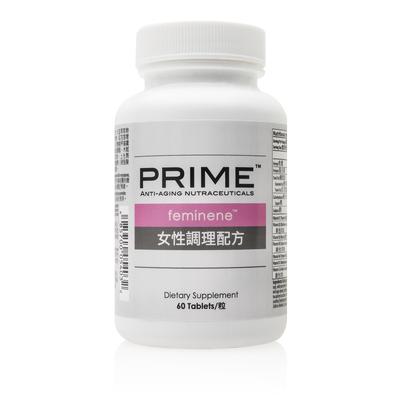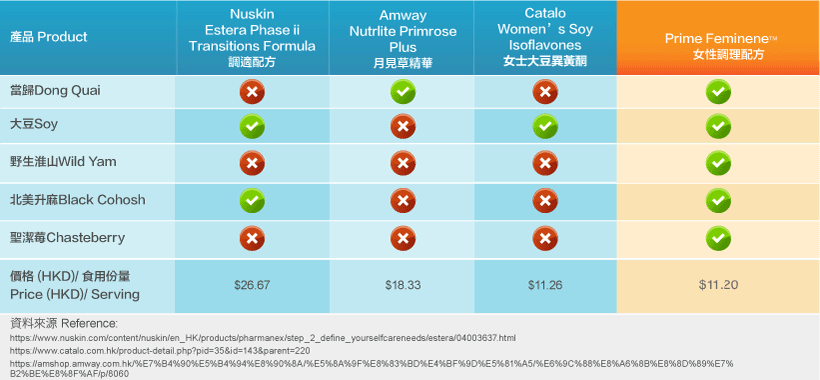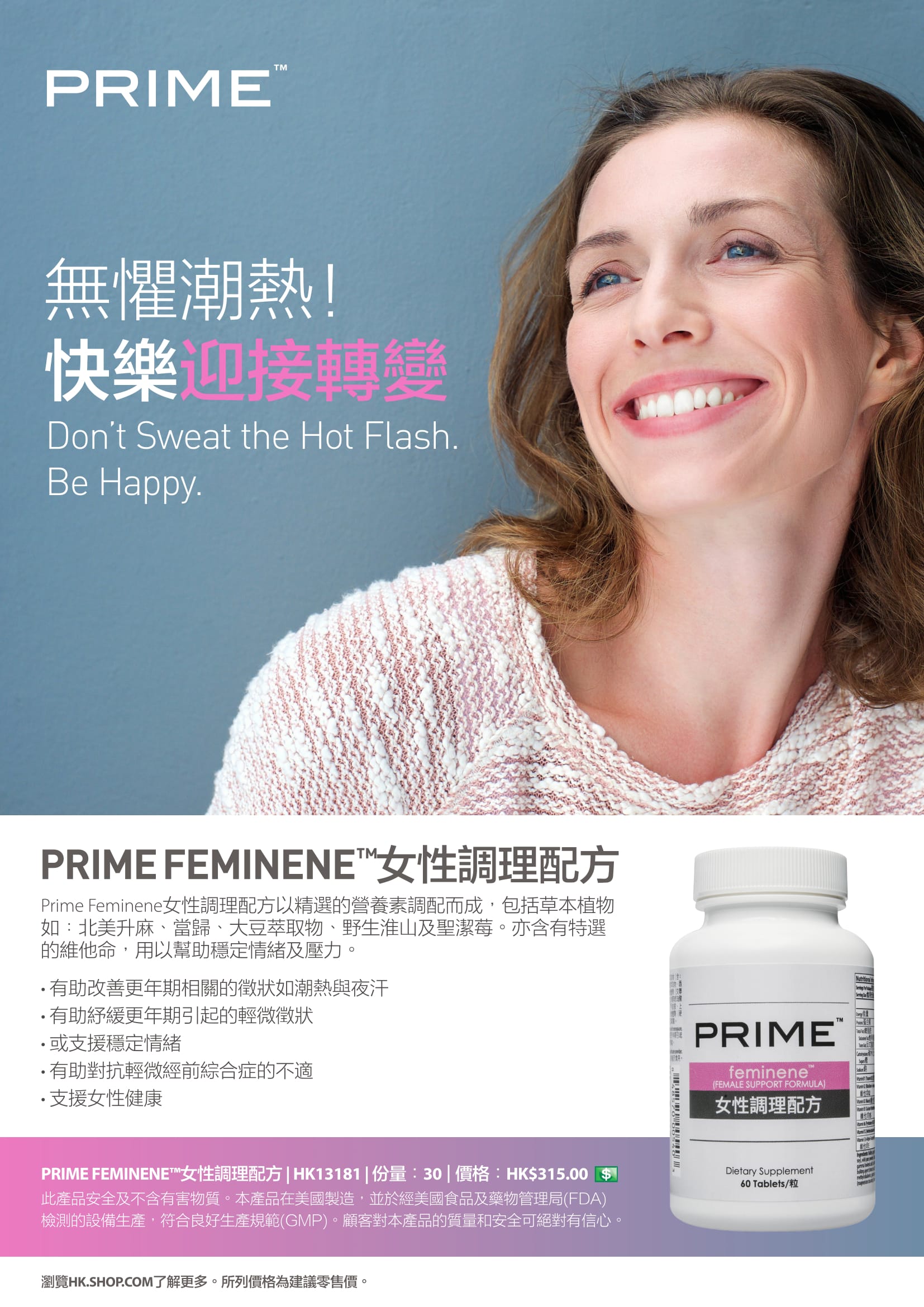健康的生活方式改變讓你發現一個全新的自我

益處
- 有助改善更年期相關的徵狀如潮熱與夜汗
- 有助紓緩更年期引起的輕微徵狀
- 或支援穩定情緒
- 有助對抗輕微經前緊張綜合症的不適
- 支援女性健康

產品分類
不含麩質 - 本產品不含可檢測出之麩質*
純素 - 本產品不含動物相關成份
品質標準 - 良好生產規範(GMP)運作與標準化成份
已檢測:重金屬丶微生物污染物丶過敏原丶效力丶純度及特性
*美國食品藥品監督管理局(FDA)將含有少於20PPM麩質的製成產品列為不含麩質
詳細資料
更年期是自然的生理過程,通常指的是女性自然停經的時間已達一年。常見的相關徵狀包括情緒及生理上。情緒徵狀包括:情緒不穩定、失眠、煩躁易怒、缺乏精力及心情低落。常見的生理徵狀則為夜汗及潮熱。香港婦女進入更年期的平均年齡為51歲。部份婦女在40歲時就會出現更年期,而部份婦女可能到54歲仍維持正常的經期。此外,部份婦女在更年期前會經歷前期更年期,亦即停經期,出現更年期相關的徵狀。
許多女士於這個階段,仍努力建立事業、家庭、朋友及承諾,因此解決更年期或停經期出現的徵狀有助她們紓緩不適。一些科學研究已經證實精選的草本植物、維他命及礦物質幫助促進女性健康,尤其是在更年期或停經期。也不會如其他非天然的方式帶來不良的副作用。
經前緊張綜合症(PMS)是另一個女性會經歷的自然生理過程,會在經期前兩週就開始,且與荷爾蒙缺乏或過多有關。經前緊張綜合症的徵狀包括:惱火及壓力增加、腹脹、胸部脹痛、腹部不適、情緒不穩、短期疲倦、頭痛、防衛心重、睡眠障礙、關節不適、情緒波動以及神經緊張。顯然,紓緩經前緊張綜合症的不適對許多女士都非常重要。
Prime Feminene 女性調理配方為營養補充品,配方有助減輕潮熱及夜汗,同時也可減輕與更年期、停經期或經前緊張綜合症有關的輕微不適。本產品有助穩定情緒,以天然的方式幫助女性順利度過這些階段。
Prime Feminene女性調理配方以精選的營養素調配而成,包括草本植物如:北美升麻、當歸、大豆萃取物、野生淮山及聖潔莓。亦含有特選的維他命,用以幫助穩定情緒及壓力。本產品有助女性保持生理平衡,從而擁有更均衡的生活。當忙於處理生活中各項大小事情時,女性更不能讓壓力及不穩情緒影響著。

成份
北美升麻是一種灌木植物,源於北美洲東部的落葉林。傳統上,北美升麻可用於紓緩經痛。它也常用於紓緩更年期及經前緊張綜合症所引發的潮熱。雖然具體機制仍然不明,但三萜甙、異黃酮、生物鹼及多酚酸都被視為主要活性成分。北美升麻可以幫助紓緩更年期的徵狀。
大豆萃取物
大豆萃取物內含作為植物雌激素形式存在的異黃酮。植物雌激素是來自植物的非類固醇複合物。大豆異黃酮包含三種主要異黃酮:金雀異黃酮、木質素異黃酮及黃豆素異黃酮。大豆可能與紓緩輕微更年期徵狀及促進骨骼健康有關。
當歸萃取物
當歸已經在中國及美洲原住民的傳統醫學上使用數千年。這種植物與芹菜及西芹屬於同類,其有益健康的特性來自根部。當歸常被稱為「女性專用人參」,因為它能在經期發揮維持體內平衡的作用。它最常用來改善經期的輕微抽搐與痛楚,或紓緩輕微更年期徵狀,例如潮熱。雖然仍不清楚具體的運作機制,但香豆素、阿魏酸及藁本內酯等似乎是當歸的活性成分來源。香豆素促進正常的血液循環,而阿魏酸與藁本內酯促進肌肉正常的放鬆。當歸不是雌激素的替代品,(不過有研究顯示它具有跟異黃酮相似的功效),也不會對身體產生任何與荷爾蒙相似的作用。
野生淮山
野生淮山屬薯蕷科類,與馬鈴薯同屬一類。薯蕷科被命名為Dioscorides,來自第一世紀的希臘醫生Dioscorides,他所撰寫的植物學著作被視為標準參考達一千多年。乾後的根部是野生淮山有益健康的部分。野生淮山自古便用來改善經期與更年期有關的輕微徵狀,包括抽搐、潮熱及偶爾疲倦。這種植物源於北美洲,但全世界的熱帶、亞熱帶及氣候溫和的地區皆可種植。野生淮山有助調節經期及更年期。
聖潔莓萃取物
聖潔莓萃取物或黃荊是一種原生長於地中海及亞洲中部的灌木類,但也能在美國各地發現。它一般被用作紓緩經前緊張綜合症及更年期的營養補充品。蔓荊子黃素、異牡荊素及葒草素三種類黃酮是聖潔莓萃取物的主要成分。它亦常被用作促進健康的月經週期。
木賊萃取物
木賊又稱為問荊、馬尾草、金絲桃、紅千層等,其命名來自於其節狀及毛絨絨的莖部。這種植物遍布於北半球,只有莖部擁有對健康有益的特性。它能幫助身體排除多餘的水分。木賊是矽、鐵及鈉的天然來源,同時富含鈣、鉻、粗纖維、鎂、鉀、硒及維他命A。木賊是理想的矽酸來源,為健康提供支援。木賊已被證實有助於紓緩經前緊張綜合症及更年期的輕微徵狀。
紅花苜蓿萃取物
紅花苜蓿如大豆一樣,含有豐富的異黃酮。研究顯示,紅花苜蓿有助減輕更年期引起的潮熱。紅花苜蓿擁有紅色或白色的花朵,是四季生長的小草本植物。它源於歐洲、亞洲中部及北非,但也已經廣泛引進到世界各地。只有花的部分用於營養補充品。做成的產品包括乾燥植物被用作於草本、片劑或膠囊及酒精溶液。
纈草萃取物
纈草根會開出亮粉紅色或白色的花朵,生長高度為20到40吋。它源於歐洲和亞熱帶地區,目前亦種植於歐洲、日本及美國。古希臘醫生Galen將纈草稱為「Phu」,是因為聞到它的臭味時所發出的聲音。它具有天然的療效,因此在中世紀時期被稱為萬靈丹。通常被製成茶,以膠囊、片劑,或入浴劑使用。纈草根常作自然睡眠,但也用於改善經前緊張綜合症及更年期的輕微徵狀。臨床實驗顯示根部萃取物能有助入睡,研究人員相信這是因為它容易提升γ-胺基丁酸含量,亦即大腦的化學傳訊物質。
西番蓮萃取物
西番蓮又稱為受難花,能有效改善偶爾的煩躁不安和輾轉難眠。西番蓮是四季生長的藤本植物,長度可達30呎。它的生長範圍覆蓋美國東南部到巴西與阿根廷,在歐洲則被當作園藝植物栽種。盛開的西番蓮被認為象徵「基督受難」,因為中央的花冠代表「荊棘冠」,這是別名「受難花」的由來。這種植物的健康價值來自生長於地面上的部分。西番蓮可製成花茶,也能成為一些入浴劑的成分。
丹参萃取物
丹参(藥用鼠尾草)多年來一直作為營養補充品被使用。鼠尾草源於地中海地區,但今日歐洲及北美洲各地都有種植。鼠尾草在美國主要用於調味,但藥用價值在其他國家已經有很長的一段歷史。鼠尾草的健康價值來自壓碎、風乾的葉子,以及萃取自花、葉、莖的油。它具有多樣的用途,包括有助潮熱徵狀。這種植物特別針對子宮,有助紓緩經前緊張綜合症的輕微不適,包括抽搐。它也能紓緩因潮熱而引致的多汗。
刺蒺藜萃取物
刺蒺藜為四季生長植物,一般生長於印度和非洲。常用於阿育吠陀混合物。報告指出它有助支援身體功能,及促進理想血液循環。它的活性成分包括皂甙。
硫胺素(維他命B1)
硫胺素對碳水化合物的代謝和神經功能不可或缺。健康的神經系統需要硫胺,協助製造神經傳導物質乙醯膽鹼和γ-胺基丁酸(GABA)。硫胺用於製造胃酸,因此在消化及新陳代謝功能上扮演重要的角色。
泛酸(維他命B5)
泛酸(維他命B5)是水溶性的維他命,參與克雷氏循環的能量製造當中,並且促進神經傳導物質乙醯膽鹼的正常製造。當神經脈衝由大腦傳送到神經末梢時,便會釋放出一種名為乙醯膽鹼化學物質,因而維護促進大腦的健康。泛酸跟維他命B1、維他命B2及維他命B3一起發揮作用,促進身體正常三磷酸腺苷(ATP)的產生,作為身體運作的能量。維他命B5亦有助製造及傳送脂肪,並從脂肪中釋放能量。
菸鹼酸(維他命B3)
維他命B3是水溶性的維他命,對健康、生長和生殖的許多層面來說都是必需的。它是維他命B群之一。菸鹼酸有助維持消化系統、皮膚及神經的功能。同時也有助轉化食物為能量。菸鹼酸(一般又稱為維他命B3)多存在於乳製品、家禽、魚類、瘦肉、堅果、蛋、豆類、添加營養麵包及穀物中。
核黃素(維他命B2)
維他命B2是水溶性維他命,幫助身體處理氨基酸和脂肪,活化維他命B6和葉酸,促進碳水化合物轉換成三磷酸腺苷(ATP),作為身體運作的能量。維他命B2存在於肝臟、乳製品、深綠色蔬菜和某些種類的海鮮。維他命B2是一種輔酵素,和其他的維他命B產生協同作用。維他命B2促進血液和神經系統的健康,以及正常人體生長。維他命B2促進皮膚、指甲及頭髮健康生長,並且將食物轉成能量,作為電子傳遞鏈的一部分,驅動細胞能量。維他命B2支援脂肪分解。維他命B2除非大量攝取,否則無法儲存於人體內,因此必須每日補充。
維他命B6
維他命B6的主要來源是家禽、魚類、全穀類及香蕉。維他命B6促進多種體內代謝的途徑。其中一項指定功能為促進大腦內神經傳導物質與周圍神經細胞的正常合成。維他命B6亦促進穀胱甘肽的正常產生,進而支援排毒。維他命B6支援多種氨基酸的製造和分解。維他命B6支援紅血球和白血球的健康。維他命B6促進血紅蛋白的正常合成(血紅蛋白是紅血球的蛋白質部分,負責將氧氣輸送到身體各處)。
葉酸
葉酸主要在蔬果中找到。深綠色蔬菜、橙、橙汁、豆類和豌豆是葉酸的最佳來源,而啤酒酵母除含有葉酸外,更額外提供含有其他B類維他命。葉酸可以提升維他命B12補充品的功效。葉酸支援氨基酸和蛋白質的正常利用。科學研究已經發現,當葉酸跟維他命B12一起使用時,能支援心血管及神經系統的健康。葉酸是一種維他命,促進細胞複製與生長,促進支援身體基因-DNA及RNA的正常形成促進蛋白質於細胞的合成。
甲基氰鈷胺(維他命B12)
甲基氰鈷胺是維他命B12在人體存在的天然形態之一。肝臟必須將氰鈷胺(營養補充品中最常用的B12)轉化為甲基氰鈷胺,然後才能被身體充分利用。比起處於靜態的維他命B12,甲基氰鈷胺更有效用。甲基氰鈷胺亦可促進S-腺苷甲硫胺酸(SAMe)的正常形成,SAMe是對情緒具有正面影響的營養素。維他命B12存在於動物製品,特別是內臟如肝臟;另外有少量來自花生及發酵豆類製品,例如麵豉和豆豉。素食者必須使用維他命B12補充品以維持最佳的健康狀態。維他命B12在攝取後儲存於肝臟和其他組織內,以供日後使用。維他命B12維護細胞健康,特別是神經系統、骨髓及腸道的細胞。維他命B12促進同半胱胺酸正常代謝(同半胱胺酸是在體內形成的一種氨基酸)。正常的同半胱胺酸含量對維持心血管健康很重要。葉酸和維他命B12會以活性輔酵素的形式,幫助維持血液中的同半胱胺酸於正常水平。維他命B12本身負責維持最佳的精力狀態,因為它在檸檬酸循環中扮演關鍵角色。
維他命E
維他命E重要的飲食來源包括蔬菜油、人造牛油、果仁、種籽、牛油果和小麥胚芽。維他命E實際上為生育酚和生育三烯酚相關複合物的家族。維他命E主要的功能在於它可促進免疫功能的抗氧化活動。維他命E亦促進正常癒合,同時促進心血管健康。維他命E是體內最有效的脂溶性抗氧化物之一。維他命E更可保護細胞膜免受自由基的傷害。研究已經顯示,補充維他命E有助紓緩輕微的經前緊急綜合症不適。
常見問答
甚麼是更年期?
更年期是指女性逐漸停止月經的時期。當停止月經超過一年,便是更年期。更年期的常見徵狀為情緒及生理上的改變、情緒不穩、失眠、潮熱及夜汗等。部份女士在進入更年期前會經歷停經期。直到完全停經前,女士有機會經歷更年期的症狀。停經期間與更年期最常見的症狀是潮熱、發熱、出汗;33%處於停經期間與更年期的女性會尋求藥物來紓緩不適。
甚麼是雌激素?
雌激素是複合類固醇,名稱因為其於生理週期的重要性以來。主要作為女性賀爾蒙。男性與女性體內都有雌激素,但生育年齡階段的女性體內數量明顯高出許多。雌激素主要來自初期卵子,但肝臟、腎上腺及胸部分泌作為第二主要來源亦會製造雌激素。第二主要來源提供的雌激素對停經後的女性異常重要。
雌激素可促進女性第二性徵發育、刺激子宮內膜生長、增進子宮生長、維持血管與肌膚健康及骨骼形成。
甚麼是更年期的成因?
雌激素減少會引起更年期症狀。然而,不是所有更年期徵狀都可用雌激素改善。
甚麼是賀爾蒙補充治療?
賀爾蒙補充治療是一套針對停經期間及停經後女性的藥物治療。這是基於假設治療能預防因雌激素的減少而引起的不適與健康問題。賀爾蒙補充治療包括一系列的藥物來人工提升賀爾蒙的水平,使用雌激素、黃體酮或黃體素,有時還會使用睪丸酮。賀爾蒙補充治療被視為短期紓緩更年期症狀或作為降低骨質疏鬆狀況的長期治療。
何時出現更年期?
香港婦女進入更年期的平均年齡為51歲。部份女士在40歲時就會出現更年期,而部份女士可能到54歲仍維持正常的月經期。
有哪些常見對付更年期的營養補充品,屬非荷爾蒙類別?
最常見的非賀爾蒙補充品為北美升麻、月見草油、紅花苜蓿、維他命B群及維他命E。
甚麼是甚麼是經前緊張綜合症(PMS)?
PMS是經前緊張綜合症,與賀爾蒙過多及過少都有關係。壓力、營養不足及其他營養或生活模式的因素都會引發經前緊張綜合症現象。與經前緊張綜合症相關的常見徵狀包括壓力及體重增加。
何時出現經前緊張綜合症?
經前緊張綜合症(PMS)最早可於月經前兩週就會發生。
經前緊張綜合症(PMS)普遍嗎?
有經前緊張綜合症的女性的百分比很高。根據一項香港研究顯示,66名在職女士當中,92%表示於經期前出現徵狀。比起經前的負面影響,她們較多會感到疲倦及經痛。
有任何食物會使經前緊張綜合徵狀更嚴重嗎?
有。有些食物顯示會使經前緊張綜合症的徵狀更嚴重,如飽和脂肪、反式脂肪、精製糖、鹽、咖啡因及酒精。
如何使用此產品?
作為營養補充品,每日使用兩粒,或按醫護人員指示服用。
使用此產品有甚麼需要特別注意的事情嗎?
有。如果你正在服用薄血丸(Coumadin)、其他抗血小板/抗凝血藥,使用本產品前請向你的醫護人員諮詢。如果你目前患有長期疾病或正在服用處方藥物,或婦女在懷孕或哺乳期間,使用本產品前請先諮詢醫護人員。如果你對所列的任何成分過敏,請勿食用本產品。
Prime Feminene女性調理配方安全嗎?
Prime Feminene女性調理配方安全,且不含有害成分。本產品在美國製造,並於經美國食品及藥物管理局檢測的設備生產,符合良好生產規範。顧客對本產品的質量和安全可絕對有信心。
科學
Albertazzi P et al. Dietary soy supplementation and phytoestrogen levels. Obstet Gynecol. 94:229-31, 1999.
Albertazzi P et al. The effect of dietary soy supplementation on hot flushes. Obstetrics and Gynecology. 91(1): 6-11, 1998.
Atmaca M, Kumru S, Tezcan E. Fluoxetine versus Vitex agnus castus extract in the treatment of premenstrual dysphoric disorder. Hum Psychopharmacol. 18:191-5, 2003.
Benton D., et al. Thiamine supplementation for mood and cognitive functioning. Psychopharmacology. 129(1):66-71, 1997.
Benton, D., et al. The effects of nutrients on mood. Public Health Nutr. 2(3A):403-409, 1999.
Berger, D., et al. Efficacy of Vitex agnus castus L. extract Ze 440 in patients with pre-menstrual syndrome (PMS). Archives of Gynecology and Obstetrics. 264(3): 150-153, 2000.
Bommer S, Klein P, Suter A. First time proof of sage's tolerability and efficacy in menopausal women with hot flushes. Adv Ther. 28:490-500, 2011.
Bryant, M et al. Effect of consumption of soy isoflavones on behavioural, somatic and affective symptoms in women with premenstrual syndrome. Br.J.Nutr. 93(5):731-739, 2005.
Carroll, D. Nonhormonal therapies for hot flashes in menopause. American Family Physician. 73(3): 457-465, 2006.
Cassidy, A., et al. Biological effects of a diet of soy protein rich in isoflavones on the menstrual cycle of premenopausal women. American Journal of Clinical Nutrition. 60(3): 333-340, 1994.
Cheng, G., et al. Isoflavone treatment for acute menopausal symptoms. Menopause. 14(3 pt 1): 468-473, 2007.
Ciotta, L et al. Psychic aspects of the premenstrual dysphoric disorders. New therapeutic strategies: our experience with Vitex agnus castus. Minerva Ginecol. 63(3):237-245, 2011.
Duncan AM, Underhill KE, Xu X, et al. Modest hormonal effects of soy isoflavones in postmenopausal women. J Clin Endocrinol Metab. 84:3479-84, 1999.
Hardy, M. Herbs of special interest to women. Journal of the American Pharmaceutical Association. 40(2): 234-242, 2000.
Hidalgo LA et al. The effect of red clover isoflavones on menopausal symptoms, lipids and vaginal cytology in menopausal women: a randomized, double-blind, placebo-controlled study. Gynecol Endocrinol. 21(5):257-264, 2005.
Kurzer M. Hormonal effects of soy isoflavones: Studies in premenopausal and postmenopausal women. J Nutr. 130:660-1, 2000.
Larsson, B., et al. Evening primrose oil in the treatment of premenstrual syndrome. Current Therapeutic Research. 46(1): 58-63, 1989.
Laux, M., et al. Natural products: healthy and safe alternatives to hormone replacement therapy. Revista Latinoamericana de Quimica. 35(1-2): 20-32, 2007.
Liske E et al. Physiological investigation of a unique extract of black cohosh (Cimicifugae racemosae rhizoma): a 6-month clinical study demonstrates no systemic estrogenic effect. J Womens Health Gend Based Med. 11:163-74, 2002.
Loch E., et al. Treatment of premenstrual syndrome with a phytopharmaceutical formulation containing Vitex agnus castus. Journal of Women’s Health and Gender-Based Medicine. 9(3): 315-320, 2000.
Ma, L., Lin, S., Chen, R., and Wang, X. Treatment of moderate to severe premenstrual syndrome with Vitex agnus castus (BNO 1095) in Chinese women. Gynecol.Endocrinol. 26(8):612-616, 2010.
Mayo, J. Black cohosh and chasteberry: herbs valued by women for centuries. Clinical Nutrition Insights. 6(15); 1-4, 1998.
Miyasaka LS1, Atallah AN, Soares BG. Passiflora for anxiety disorder. Cochrane Database Syst Rev. 24;(1):CD004518, 2007
Monograph. Angelica sinensis. Alternative Medicine Review. 9(4): 429-433, 2004.
Mori A, Hasegawa K, Murasaki M, et al. Clinical evaluation of Passiflamin (passiflora extract) on neurosis - multicenter double blind study in comparison with mexazolam. Rinsho Hyoka (Clinical Evaluation). 21:383-440, 1993.
Nappi RE, Malavasi B, Brundu B, Facchinetti F. Efficacy of Cimicifuga racemosa on climacteric complaints: a randomized study versus low-dose transdermal estradiol. Gynecol Endocrinol. 20:30-5, 2005.
Nicholls J, Lasley BL, Nakajima ST, et al. Effects of soy consumption on gonadotropin secretion and acute pituitary responses to gonadotropin-releasing hormone in women. J Nutr. 132:708-14, 2002.
Oktem M et al. Black cohosh and fluoxetine in the treatment of postmenopausal symptoms: a prospective, randomized trial. Adv Ther. 24:448-61, 2007.
Pino AM, Valladares LE, Palma MA, et al. Dietary isoflavones affect sex hormone-binding globulin levels in postmenopausal women. J Clin Endocrinol Metab. 85:2797-800, 2000.
Pockaj BA et al. Pilot evaluation of black cohosh for the treatment of hot flashes in women. Cancer Invest. 22:515-21, 2004.
Shams T, Setia MS, Hemmings R, et al. Efficacy of black cohosh-containing preparations on menopausal symptoms: a meta-analysis. Altern Ther Health Med. 16:36-44, 2010.
Sun J. Morning/evening menopausal formula relieves menopausal symptoms: a pilot study. J Altern Complement Med. 9:403-9, 2003.
Wuttke, W., et al. Chaste tree (Vitex agnus castus)- pharmacology and clinical indications. Phytomedicine. 10: 348-357, 2003.
評論
顯示 1 - 5 的 6
15/2/2025
而 KO
調經聖物
工作緊張,近年經期不穩定,經常推遲,食用這個補充品一個月,本月經期居然準時。我很喜歡產品清香的當歸味,再睇成份配方,都是女士恩物,有用,抵用,正啊👍
顧客服務部的回覆
19/2/2025
親愛的顧客,感謝您抽出寶貴時間對Prime™ 女性調理配方發表意見。我們很高興您對產品感到滿意。再次感謝閣下對美安的支持!
超連鎖店主服務部 謹啟
29/6/2023
而 CarolL
女士恩物
有當歸味和葉酸,還有B1,B3,B6 和B12,具備女士必需元素,非常好,用後皮膚有色澤,早餐之後食2粒
顧客服務部的回覆
30/6/2023
致 親愛的顧客,感謝您抽出寶貴時間對Prime™ 女性調理配方 發表意見。我們很高興您對產品感到滿意。再次感謝閣下對美安的支持!
超連鎖店主服務部 謹啟
17/5/2022
而 家維劉
請問 金雀異黃酮的產品說明 非植物性~~但是產品是全素 非植物性是什麼意思呢
金雀異黃酮的產品說明 非植物性~~但是產品是全素 非植物性是什麼意思呢
顧客服務部的回覆
26/5/2022
感謝您聯絡美安公司。Prime™女性呵護配方膠囊食品中的金雀異黃酮 (geniVida®†)為實驗室合成的成分,並非從植物中萃取,亦非萃取自動物來源,因此本產品為全素產品。提供您參考,謝謝您。
18/8/2021
而 匿名
產品查詢
初次使用,按照建議每日兩粒,請問分兩次食?還是一次吃兩粒?
早上或下午及空腹還是飽腹食用吸收率會更高?
顧客服務部的回覆
18/8/2021
致 親愛的顧客,
謝謝您抽出寶貴時間對 Prime™ 女性調理配方 提出寶貴意見,超連鎖店主服務部將與您聯繫,並協助解決此問題。
如果您想直接致電給我們,請在週一至週五的上午11:00至下午7:00之間致電852-35129198與我們聯繫。
再次感謝閣下對美安的支持!
超連鎖店主服務部 謹啟
18/5/2020
而 慧敏葛
資詢
多囊性卵巢症候群 能吃嗎?
顧客服務部的回覆
25/5/2020
感謝您聯絡美安公司。如果您的消費者正在服用華法林(可邁丁)、其他抗血小板/抗凝血劑、糖尿病藥物、雌激素或任何處方藥物,或者患有疾病,食用本產品前請向醫護人員諮詢,提供您參考,謝謝您。
- <上一頁
- 下一頁


